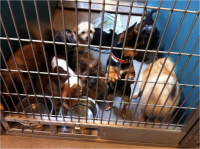Animal Rescue-Charnal Ground Practice
Ordinarily when we witness suffering, we turn away. Alex Milsom shows how working in animal rescue deepens her practice. This is a first in a series of blogs exploring practitioners relationships with animals.
Since moving to Los Angeles, I have volunteered for an organization called Karma Rescue – a dog rescue that specializes in the pit bull-type dogs that get killed at the rate of 200 per day in the city’s shelters. I help decide which dogs we will pull from the shelters and put into foster care and training, and exploring the dark corners of our city’s animal facilities has had some unexpected consequences in my way of valuing life and assessing suffering.
When there are more animals being brought into the city and county shelters than there is space for, then the dogs who have been housed in the facilities longest get “red-listed,” or killed via injection. Publication of the high rates of healthy-dog euthanasia caused an outcry about ten years ago and pressure was put on the city to lower this number. (You can view monthly euthanasia rates here.) The result of this well-meaning outcry meant that the shelters’ kennels became so overcrowded that the animals would get into fights—imagine a 4×8 kennel filled with ten 50-pound dogs—and then as a result of injuries sustained, would be euthanized anyway. This solved the problem of having to report healthy-dog death rates, because after fighting, these dogs were no longer considered healthy. The dark logic of this system meant that the same numbers of dogs were dying in the shelters, but the stats had been laundered such that they appeared more palatable to the public.
If you visit a city animal shelter today—something I do quite regularly as a person now authorized to select which animals our organization can place in its adoption program—you will see that pit bulls and other large breeds are alone in their own kennels. The city has returned to its former model wherein it euthanizes dogs rather than forcing them to crowd into small kennels together. When I see these single dogs pacing in circles around their pens, attempting to launch themselves against kennel walls, or squash their faces against the gate to offer a tongue to my inquiring hand, I also imagine the ghosts of all the dogs who have lived there in the months and years past-all the dogs who have had to die so that this new one could move in and have it all to himself.
As a Buddhist, I view this as charnel ground practice: I am familiar with the freezer into which the bodies of the dead, healthy dogs are piled while they await their removal to the local incinerator. I have held the hands of the vet techs who perform the job of injecting these animals with the chemicals that kill them. And I have had to choose which particular dog will live from a collection of hundreds that, as a direct result of my decision, will die instead.
While it may be troubling to see the dark reality of animal control in this city, I became convinced that there are things worse than death for these animals. During a rescue-effort I participated in two years ago in the Mojave Desert, where I saw hundreds of dogs (and thousands of cats) living in utter squalor and with continual pain on the property of an animal hoarder, I learned a very dark truth: that death is not the worst consequence of animal over-population. To see a video produced about my role in that rescue, click here.
What plagues me most in this work is that the overcrowding of shelters and the mass extermination of perfectly healthy animals (cats, rabbits, reptiles, and so forth) is that this is one of the few societal problems with an easy solution: animal sterilization. I have taken on the role of Chair of Karma Rescue’s Education Program and thus visit schools and juvenile prisons regularly to talk to middle and high school students about their relationships to animals. Consistently, children and young adults, even those residing in the most impoverished corners of our society—the neglected neighborhoods of Los Angeles and Compton and in the underfunded incarceration facilities where young felons are warehoused—express their affection for animals via their longing to hug the dogs that I bring (usually my own two pit bulls) and via their professions of concern for the well-being of the animals I describe as suffering in the shelters. Children and young adults understand this singular responsibility of the human being—to care for those who are vulnerable—instantly and without doubt. They get it immediately and want to help. What happens to us, between childhood and adulthood, that hardens us to suffering and numbs us to caring about the creatures who have been bred to rely upon us? When does that transition occur?
People often challenge me to justify my involvement with this rescue organization: There are people who need help too – don’t they matter more? As a Buddhist, I have been taught to regard all sentient beings as valuable. I also carry in my heart and memory indelible images of animals suffering at the hands of the human beings on whom they rely for sustenance. Mahayana teachings inform us that as practitioners we cannot choose to turn away from suffering, and that meditation practice prepares us with skillful means for helping effectively.
It is easy to raise windhorse when I sit in front of a shrine, but can I still do so when I’m looking at an animal covered in scars from being used in a fighting ring? Can I still have faith in basic goodness when I talk to young felons who spent their entire childhoods being abused by those whom they trusted and loved most? As a Dorje Kasung, I have been trained to relate with aggression, but do I really believe that we can overcome it when I keep reminding myself, with this rescue work, how much there is just in Los Angeles alone?
The Sakyong recently gave a teaching at the Creating Enlightened Society event in San Francisco in which he explained that another way to understand “basic goodness” is as the notion that the “basis” of our being holds “potential” and “richness.” He also argued that this question of human nature—is it bad? is it good?—is the most pressing question of our time. Working with children and young adults is a good way to convince oneself of the truth of basic goodness, and working with animals has been a training ground for me to connect to my own richness.
 Alex Milsom lives in Santa Monica with her two dogs and her turtle. She is getting her Ph.D. in English at UCLA where she studies Victorian literature and tourism. She helps host the Ziji Collective’s Young Meditator’s Group on Monday nights at the West Side Center and is a Kasung.
Alex Milsom lives in Santa Monica with her two dogs and her turtle. She is getting her Ph.D. in English at UCLA where she studies Victorian literature and tourism. She helps host the Ziji Collective’s Young Meditator’s Group on Monday nights at the West Side Center and is a Kasung.




I commend you on your wonderful work. I currently have two pits, the latest one recently adopted from the North central animal shelter. My daughter volunteers with Angel City Pits, where she got her pit from. We love the “Dogman” free training classes on Sundays at the Coliseum.
Thank you so much for all you do to save these wonderful dogs who are so maligned.
Renee –
Yes I actually know Dogman myself and have taken my dogs to his classes a bunch of times – he’s a friend of mine through rescue work. I also know a lot of volunteers at ACP and they are great. Pits are the best – Keiko also comes from North Central!
🙂